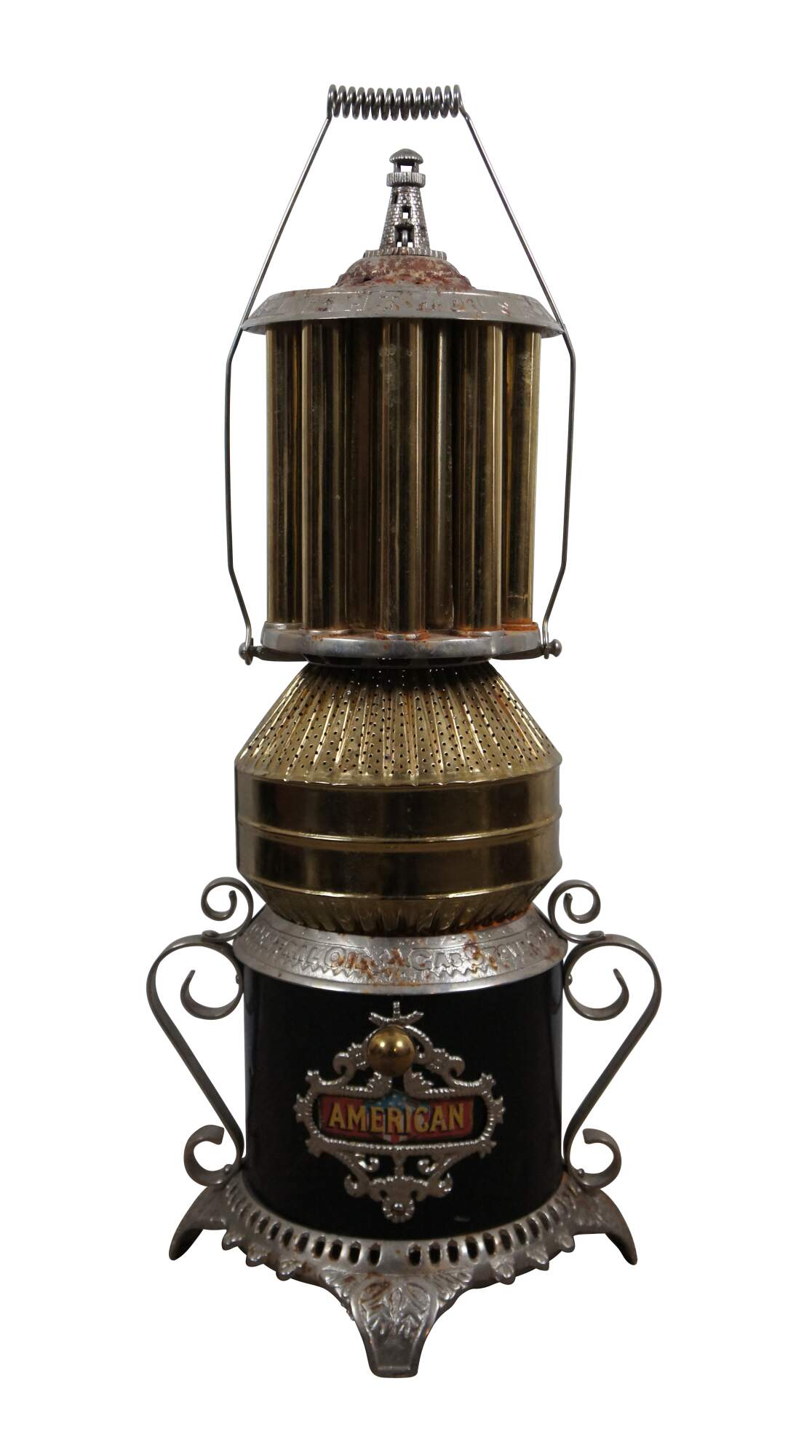
Shipping:
Free Shipping Included
Delivery:
Estimated 2-15 Business Days
Payments:
Credit Card, Check, Cash, PayPal, Apple Pay, Venmo
Returns:
30 Days 100% Money Back Guarantee, Buyer Pays Return Shipping
Description
A rare and impressive American Central Oil & Gas Lighthouse 110 parlor or cabin heater. The heater has a lighthouse finial paying homage to the Cape May Lighthouse.
The Cape May Lighthouse is one of the oldest operating lighthouses in the United States. It's located in Cape May Point State Park and has been guiding navigators into the Delaware Bay since 1859. The lighthouse has a cast iron spiral stairway with 199 steps. The lighthouse is 110 feet tall hence No. 110
Baby boomers who grew up in Gardner may recall visits to their grandmother’s house that had a large Florence stove occupying space in the kitchen.
Dating back to the 1880s, they were manufactured at the American Oil Stove Co. in Gardner, later at the Central Oil and Gas Co., and by 1924 it became Florence Stove.
At one time, it held Gardner’s second largest workforce, second only to furniture manufacturer Heywood-Wakefield Co.
What people may not realize is that the stove company was not named Florence for a person but rather for the place where the wickless-type kerosene burner was invented and adapted into a cooking appliance.
It was in the small town of Florence, Mass. – next door to Northampton – where William H. Wilder invented the kerosene burner in 1872. The most amazing thing about the invention was that Wilder was only 17-years old when he contracted with the Florence Machine Co., which at the time was manufacturing sewing machines, to build the ranges for him.
Wilder was the only man from Gardner to be elected to the U.S. Congress in Washington, D.C., but before that time he formed the American Oil Stove Co. in Gardner in 1884. Joining forces with Alvin M. Greenwood and Calvin H. Hill, the men began to develop some of Wilder’s inventions to initially manufacture Florence kerosene ranges at the plant on lower School Street.
In 1890, Central Oil and Gas Co. took over the business and moved the operations back to a factory in Florence. A short time later, an economic depression dubbed “the Panic of 1893” nearly wiped out Wilder, leaving him on the brink of bankruptcy.
He was able to reorganize the Gardner plant by 1896 and the company soon began working on gas appliances, such as hot plates and gas burners. In no time, the business began to flourish and the local facility expanded over 10 and one-half acres of land.
A disastrous fire on April 19, 1899, destroyed the main factory on School Street.
Since Wilder was well connected within the community, it didn’t take long for the locals to come to his aid. In less than a week’s time, a temporary structure was fashioned helping with the manufacture of stoves.
After Wilder died in 1913, his son, Solon Wilder, became president of the Central Oil and Gas Stove Co. until his death at the age of 39 in 1922. It became organized in 1924 under Joseph P. Carney, who proposed the name the Florence Stove Co.
Kerosene ranges were still a major part of the business, while the company also began developing cabinet-type room heaters, wickless kerosene burners and the first “look-in” windows for the over doors of kerosene ranges.
In time, Florence Stove opened production plants throughout the country in such locations as Kankakee, Ill., Newark, Ohio, and Lewisburg, Tenn.
During the Depression around 1933, Florence Stove was credited with introducing the first oil and gas dual-oven combination all-steel range. The following year, the company developed the first oil-burning space heaters, which connected to home chimneys.
For many years, Florence Stove in Gardner manufactured gas ranges, electric ranges, oil ranges, range oil burners, oil burning heaters and other items.
During World War II from July 1942 to late 1944, production shifted to war work. Major contracts were received for airplane parts such as wing struts, tail sections and fuel tanks. Ejection seats for jet aircraft and fuel tanks were also crafted later.
In 1952, Florence Stove purchased the Quaker Manufacturing Co., a heater manufacturer of Chicago. That acquisition would prove vital as on Feb. 2, 1954, it was announced that Florence Stove would relocate its executive offices from Gardner to Chicago.
Two years later in August of 1956, President John P. Wright announced that the Gardner plant would phase out as government war contracts were on the verge of expiring. Financial losses from the previous four years were cited as a reason for closing.
The city was stunned by this announcement. The plant closing also came as a shock to the community that had come to know Florence Stove as more than simply a local factory and employer. The business was a vital cog in the city’s industrial history.
Condition
Good Overall - Gentle wear; some surface rust
Dimensions
14" x 13" x 33" (Width x Depth x Height)